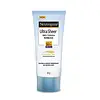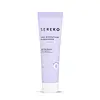What's inside
What's inside
 Key Ingredients
Key Ingredients

 Benefits
Benefits

 Concerns
Concerns

 Ingredients Side-by-side
Ingredients Side-by-side

Water
Skin ConditioningHomosalate
Skin ConditioningOctocrylene
UV AbsorberButyl Methoxydibenzoylmethane
UV AbsorberEthylhexyl Salicylate
UV AbsorberMethylene Bis-Benzotriazolyl Tetramethylbutylphenol
UV FilterEthylhexyl Triazone
UV AbsorberGlycerin
HumectantAluminum Starch Octenylsuccinate
AbsorbentSodium Potassium Aluminum Silicate
Diisopropyl Adipate
EmollientPotassium Cetyl Phosphate
EmulsifyingPhenoxyethanol
PreservativeTriacontanyl Pvp
HumectantCetyl Alcohol
EmollientGlyceryl Stearate
EmollientHydroxyacetophenone
AntioxidantSilica
AbrasiveBis-Ethylhexyloxyphenol Methoxyphenyl Triazine
Skin ConditioningTocopheryl Acetate
AntioxidantHydrolyzed Jojoba Esters
Skin ConditioningPEG-75 Stearate
Titanium Dioxide
Cosmetic ColorantDimethicone
EmollientAcrylates/C10-30 Alkyl Acrylate Crosspolymer
Emulsion StabilisingCeteth-20
CleansingParfum
MaskingSteareth-20
CleansingAcrylates/Dimethicone Copolymer
Skin ConditioningDisodium EDTA
Jojoba Esters
EmollientSodium Hydroxide
BufferingWater, Homosalate, Octocrylene, Butyl Methoxydibenzoylmethane, Ethylhexyl Salicylate, Methylene Bis-Benzotriazolyl Tetramethylbutylphenol, Ethylhexyl Triazone, Glycerin, Aluminum Starch Octenylsuccinate, Sodium Potassium Aluminum Silicate, Diisopropyl Adipate, Potassium Cetyl Phosphate, Phenoxyethanol, Triacontanyl Pvp, Cetyl Alcohol, Glyceryl Stearate, Hydroxyacetophenone, Silica, Bis-Ethylhexyloxyphenol Methoxyphenyl Triazine, Tocopheryl Acetate, Hydrolyzed Jojoba Esters, PEG-75 Stearate, Titanium Dioxide, Dimethicone, Acrylates/C10-30 Alkyl Acrylate Crosspolymer, Ceteth-20, Parfum, Steareth-20, Acrylates/Dimethicone Copolymer, Disodium EDTA, Jojoba Esters, Sodium Hydroxide
Water
Skin ConditioningPropanediol
SolventC12-15 Alkyl Benzoate
AntimicrobialGlycerin
HumectantBis-Ethylhexyloxyphenol Methoxyphenyl Triazine
Skin ConditioningMethylene Bis-Benzotriazolyl Tetramethylbutylphenol
UV FilterCentella Asiatica Extract
CleansingLecithin
EmollientSodium Acrylates Copolymer
Cellulose
AbsorbentDiethylamino Hydroxybenzoyl Hexyl Benzoate
UV FilterEthylhexylglycerin
Skin ConditioningPhenoxyethanol
PreservativeSodium Polyacrylate
AbsorbentPentylene Glycol
Skin ConditioningSodium Hyaluronate
HumectantAllantoin
Skin ConditioningAloe Barbadensis Extract
Skin ConditioningCitric Acid
BufferingSodium Gluconate
Skin ConditioningSodium Hydroxide
BufferingTocopherol
AntioxidantGlucose
HumectantSodium Lactate
BufferingTrehalose
HumectantFructose
HumectantMaltose
MaskingSodium Chloride
MaskingSodium PCA
HumectantUrea
BufferingAlgae
Skin ConditioningOrbignya Oleifera Seed Oil
EmollientWater, Propanediol, C12-15 Alkyl Benzoate, Glycerin, Bis-Ethylhexyloxyphenol Methoxyphenyl Triazine, Methylene Bis-Benzotriazolyl Tetramethylbutylphenol, Centella Asiatica Extract, Lecithin, Sodium Acrylates Copolymer, Cellulose, Diethylamino Hydroxybenzoyl Hexyl Benzoate, Ethylhexylglycerin, Phenoxyethanol, Sodium Polyacrylate, Pentylene Glycol, Sodium Hyaluronate, Allantoin, Aloe Barbadensis Extract, Citric Acid, Sodium Gluconate, Sodium Hydroxide, Tocopherol, Glucose, Sodium Lactate, Trehalose, Fructose, Maltose, Sodium Chloride, Sodium PCA, Urea, Algae, Orbignya Oleifera Seed Oil
 Reviews
Reviews

Ingredients Explained
These ingredients are found in both products.
Ingredients higher up in an ingredient list are typically present in a larger amount.
You might know this ingredient as Tinosorb S or Bemotrizinol. It is a UV filter that covers both UVA and UVB rays.
This ingredient has two peak UV absorption peaks ( 310 and 340 nm) and is able to absorb both UV-A and UV-B rays. This ingredient works by preventing UV rays from reaching and damaging your skin.
On top of that - it is highly photostable and helps prevent the photodegration of other sunscreen ingredients such as avobenzone.
Tinosorb S is allowed in the EU, Australia, and Asia. It is close to being approved by the FDA and we'll hopefully get this ingredient in the U.S. by late 2025.
Fun fact: Tinosorb S is the most effective UV absorber at maximum concentration (measured by SPF) permitted in the EU.
This ingredient is oil-soluble, so your oil-cleansers will take this right off at night.
Learn more about Bis-Ethylhexyloxyphenol Methoxyphenyl TriazineGlycerin is already naturally found in your skin. It helps moisturize and protect your skin.
A study from 2016 found glycerin to be more effective as a humectant than AHAs and hyaluronic acid.
As a humectant, it helps the skin stay hydrated by pulling moisture to your skin. The low molecular weight of glycerin allows it to pull moisture into the deeper layers of your skin.
Hydrated skin improves your skin barrier; Your skin barrier helps protect against irritants and bacteria.
Glycerin has also been found to have antimicrobial and antiviral properties. Due to these properties, glycerin is often used in wound and burn treatments.
In cosmetics, glycerin is usually derived from plants such as soybean or palm. However, it can also be sourced from animals, such as tallow or animal fat.
This ingredient is organic, colorless, odorless, and non-toxic.
Glycerin is the name for this ingredient in American English. British English uses Glycerol/Glycerine.
Learn more about GlycerinMethylene Bis-Benzotriazolyl Tetramethylbutylphenol (Tinosorb M) is a hybrid and broad-spectrum UV ingredient. It is both a UV absorber and filter.
UV absorbers are an agent that absorbs UV rays. They protect your skin by using chemical reactions to convert UV rays into heat and energy. UV filters physically reduce the amount of UV rays from reaching your skin.
Tinosorb M covers a range of 280-400 nm and is photostable. This ingredient is neither oil or water soluble.
Tinosorb M is not available in the US. However, it is available in the EU and Asia.
It's sister, Tinosorb S, is set to be approved in the US by late 2025 (fingers crossed!).
Learn more about Methylene Bis-Benzotriazolyl TetramethylbutylphenolPhenoxyethanol is a preservative that has germicide, antimicrobial, and aromatic properties. Studies show that phenoxyethanol can prevent microbial growth. By itself, it has a scent that is similar to that of a rose.
It's often used in formulations along with Caprylyl Glycol to preserve the shelf life of products.
Sodium Hydroxide is also known as lye or caustic soda. It is used to adjust the pH of products; many ingredients require a specific pH to be effective.
In small amounts, sodium hydroxide is considered safe to use. However, large amounts may cause chemical burns due to its high alkaline.
Your skin has a natural pH and acid mantle. This acid mantle helps prevent harmful bacteria from breaking through. The acid mantle also helps keep your skin hydrated.
"Alkaline" refers to a high pH level. A low pH level would be considered acidic.
Learn more about Sodium HydroxideWater. It's the most common cosmetic ingredient of all. You'll usually see it at the top of ingredient lists, meaning that it makes up the largest part of the product.
So why is it so popular? Water most often acts as a solvent - this means that it helps dissolve other ingredients into the formulation.
You'll also recognize water as that liquid we all need to stay alive. If you see this, drink a glass of water. Stay hydrated!
Learn more about Water